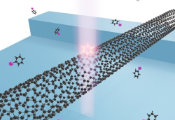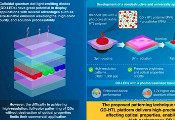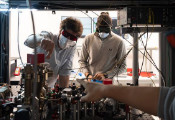University Researcher Leads Quantum Computing Project to Improve Electrical Grid Systems
December 11, 2024 -- Adding renewable energy and energy storage capacity brings an added layer of complexity to traditional electrical grid systems. Balancing supply and demand of energy for power systems, even under uncertain conditions, may be solved using quantum computing technology, according to Rochester Institute of Technology faculty-researcher Bing Yan.
Yan, an assistant professor of electrical engineering in RIT’s Kate Gleason College of Engineering, is leading a research team developing advanced optimization models and methods to manage complexities of operating the modern electrical grid through quantum computing.
Advances could improve day-to-day operations, better meet power demands and minimize costs of overall energy resources.
Yan received a grant from Independent System Operator-New England (ISO-NE), a non-profit energy resource provider, and is partnering with Junpeng Zhan, assistant professor of Renewable Energy Engineering in the Inamori School of Engineering at Alfred University, on the two-year multifaceted project.
“Unit Commitment is a critical problem in the daily operation of electrical grids, where power system operators must determine which power plants should run to meet electricity demand,” said Yan. “The objective is to minimize costs while ensuring a reliable supply of power within the operational limits of the grid.”
The researchers will deliver comparisons of state-of-the-art quantum computing methods for unit commitment problems.
Quantum computing, which leverages the unique properties of qubits enabling faster solutions to the unit commitment problem as compared with classical computers, can potentially improve the analysis process in managing large electric grid systems, Yan explained. The power grid faces numerous challenges, prompting significant research and innovation in how the integration of variable renewable energy sources, such as solar and wind, distributed energy resources, and energy storage systems can be added.
Although popular and growing, renewable technologies add a layer of complexity.
“As the dynamics on the power grid increase, solving Unit Commitment becomes increasingly critical, a task classical computing struggles to address efficiently within practical time frames. Going forward, the future grid is anticipated to be more stochastic, or randomly determined, requiring more measurement and data processing efforts for reliable and resilient grid maintenance.”
Yan has collaborated with ISO-NE since 2016, working on grid integration of renewable energy and energy storage systems. She has several national research awards, including a National Science Foundation CAREER Award, in these areas and utilizes connections to ISO-NE’s Advisory Board for feedback on the feasibility and performance of proposed models and methods being explored in her work.




































